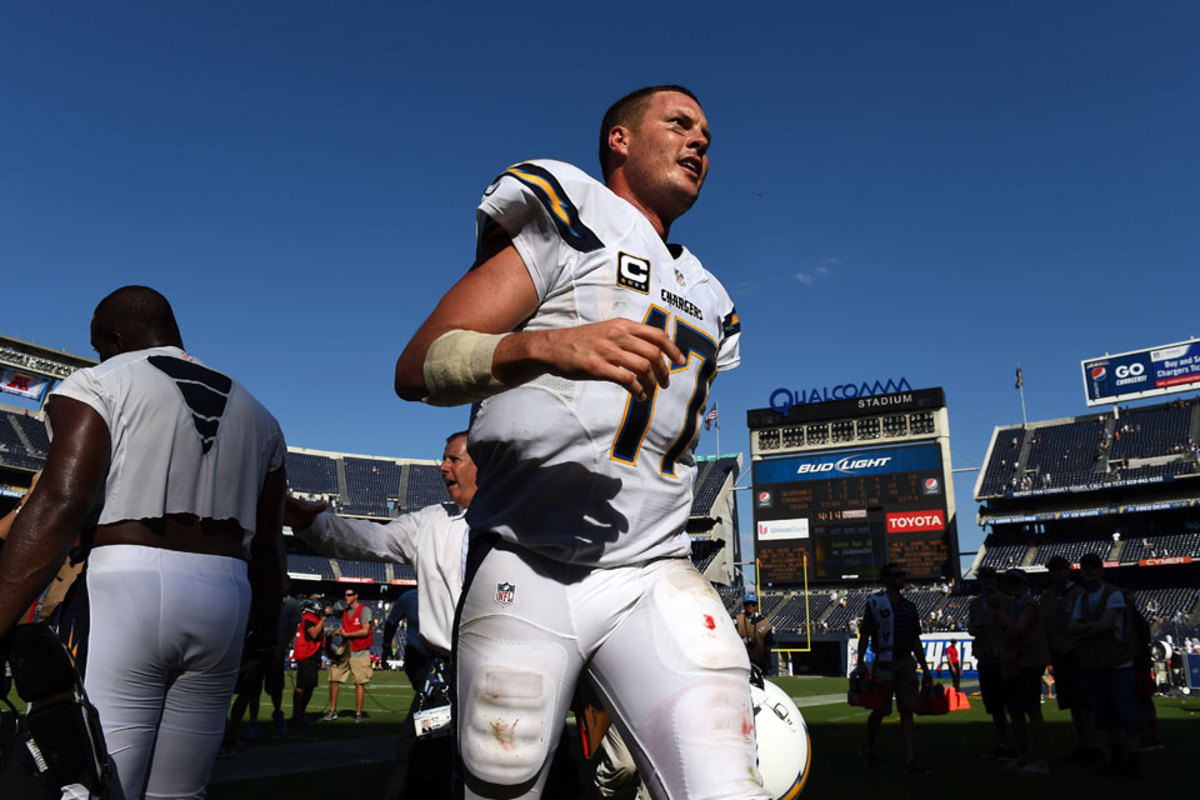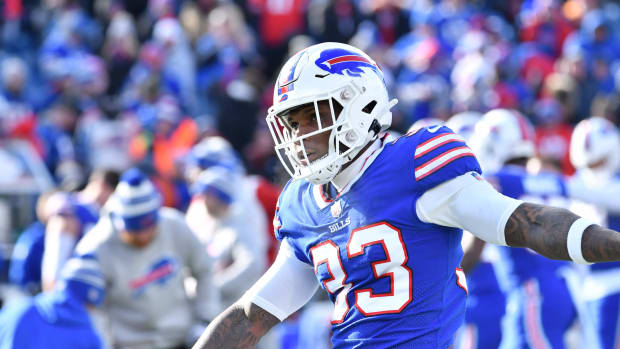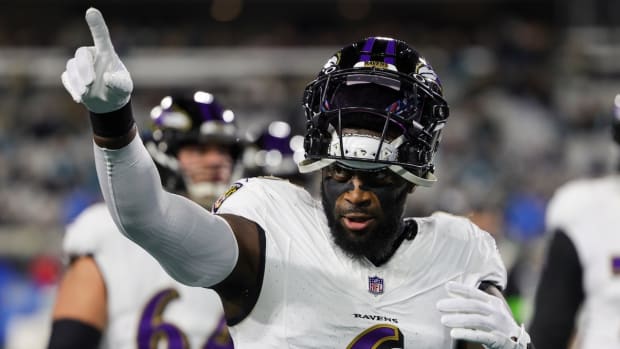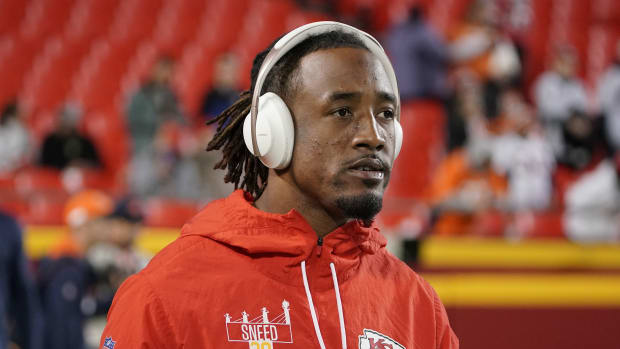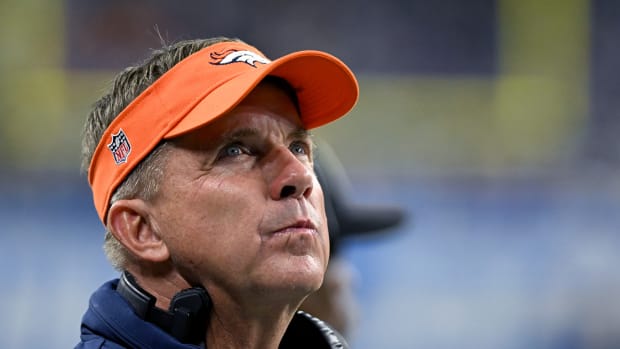How Philip Rivers Raised His Game
SAN DIEGO — If the season ended today, Philip Rivers would be MVP. This is not a matter of debate. The Chargers quarterback owns the highest completion percentage in football, 70.3%, on a 4-1 team that handed Seattle just its fourth loss in 23 months and is playing through injuries to three centers and three running backs.
That fact is nothing short of incredible, considering that by midseason 2012, then-San Diego coach Norv Turner was fielding questions about the possibility of replacing the four-time Pro Bowler and Chargers starter since ’06. Rivers had 15 picks and 15 fumbles that season as San Diego finished with a losing record (7-9) for the first time in his career. “If he doesn’t win or change this around,” former teammate Lorenzo Neal told USA Today in June 2013, “he’s the one who is going to become expendable.”
Now, after a resurgent 2013 season and four wins in a row in 2014, Rivers is batting down talk that he and this Chargers team are better than they've been for a decade. "It's a week-to-week league,” says Rivers, 32. “You can be rolling one week and be one of the best, then have an awful week and go back to what everybody thought before.
"We’ve got to keep the focus and see where it can go."
* * *
The Week 2 win over the Seahawks was a statement game for Rivers and the Chargers. (John W. McDonough/Sports Illustrated/The MMQB)
There are many ways to measure turning points, ambiguous as they are. Sometimes they pass without words, unnoticed but for careful reconstruction after the fact. In terms of watershed moments for the new and improved Chargers, a scene from 2013 training camp stands out.
San Diego had hired Mike McCoy, the Broncos’ offensive coordinator, to succeed Turner. McCoy brought in Ken Whisenhunt to run his offense and Frank Reich to serve as quarterbacks coach. During a team meeting that summer in which McCoy was installing the offense, Rivers stood up and faced the team. “We don’t have time to figure out if we’re going to buy into this new system and these coaches,” Rivers said, according to those in the room. “We’ve got to buy in from Day One.”
Says Reich: “That meant a lot to us as coaches.”
Reich (left) has had Rivers working short-to-deep, rather than the other way around. (John W. McDonough/Sports Illustrated/The MMQB)
This new Chargers offense wouldn’t be a total departure, but it would include fundamental changes. Under Turner, Rivers was among the top three quarterbacks in terms of yards per attempt to wide receivers and tight ends, but there were some misses and miscues downfield. Some of that was masked by Rivers’ success in dumping the ball off to running backs. That would end. A number of his favorite plays from the previous regime remained, but the rest of the playbook came from McCoy’s time in Denver, Whisenhunt’s run as head coach in Arizona and Reich’s tenure as an offensive assistant in Indianapolis.
The emphasis: short-to-deep reads, as opposed to deep-to-short.
“We figured out that if we could get the ball in the hands of our playmakers in space,” Rivers says, “it was as good as—or better—than a big completion downfield.” The success of that strategy is evident in Rivers’ accuracy: His completion rate since 2013 is 69.7%, a full six points higher than it was from 2006 to ’12. His touchdown rate is up from 5.3% to 6.2%. And his interception rate is down from 2.6% to 1.8%.
Rivers was open not only to new concepts in the playbook, but to a re-emphasis on old-school fundamentals. He made a list of elements of his game that he wanted to work on with McCoy, Whisenhunt and Reich. Among them: footwork in the pocket. The fumbles had to go way down, and that meant staying away from pass rushers.
These words from McCoy’s staff became gospel: “Footwork, finish. Footwork, finish. Footwork, finish.”
“It became a recommitment to that stuff,” says Reich, who took over as coordinator this year after Whisenhunt was hired as coach of the Titans. “When there’s a transition, as a player and as a coach it’s a great opportunity to recommit to some of the basics, and to his credit his ego wasn’t too big.”
* * *
On Wednesday afternoons in San Diego, the offense meets as a whole to go over blitz packages for the next opponent. Blitz day is standard across the league: The coaching staff presents a film cutup of the opponent’s blitzes and teaches it to the team.
In San Diego, Rivers makes the cutup himself and teaches it to the offense, complete with his notes on how he might audible in a given situation.
“He’s running that show on Wednesday, and I don’t think more than one or two quarterbacks in the NFL do that, probably Peyton Manning and Philip,” says Chargers veteran center Nick Hardwick, now on injured reserve. “Because he has that ability and that level of input in this offense with these coaches, you’re seeing some special things on the field.”
Reich and Hardwick provide an example: In last week’s victory over the Jets, the Chargers had the ball on second-and-6 facing a stacked box:
One play that reveals Rivers’ new prowess: Jets show blitz on 2nd and 6. (NFL Rewind)
“Normally when a team is blitzing you have two options,” Reich says. “You can call for max protection and take a deep shot, or you’re going to call a quick throw.”
Rivers recognized the look from the Wednesday film session. The standup linebacker on the left side, he surmised, would back into coverage, negating a quick throw to tight end Antonio Gates. The cornerbacks were playing eight yards off the ball, eliminating a deep throw. The scheme is meant to bait a quarterback into an interception.
Rivers recognizes the look from his film study and audibles to a run. (NFL Rewind)
Seeing the look, Rivers called for an unorthodox response, which he had already dreamed up during the week.
Hardwick: “So he says, When they show this blitz and I see it on the field, why don’t we check to the zone run away from it, and they’re completely exposed and outflanked.”
As expected, the linebacker drops into space, and Oliver is on his way to a 52-yard gain. (NFL Rewind)
The result: a 52-yard run by undrafted rookie Branden Oliver, San Diego’s fourth running back.
Says Reich: “No one else in the NFL did that this year.”
“To be in that elite group of quarterbacks, it’s about processing speed, like a computer. You can have a big hard drive, but how much RAM do you have? These elite guys—whatever the maximum amount of RAM you can have in a machine, they have it.”
* * *
There’s little chance we’d be talking about Wednesday blitz meetings and random access memory if not for the game that legitimized the Chargers as a Super Bowl contender and Rivers as an MVP frontrunner. In a 30-21 victory against Seattle in Week 2, Rivers was 28 for 37 for three touchdowns and 284 yards against the No. 1 defense of a year ago.
For perspective on how it happened, we turn to Mike Martz, retired NFL coach and San Diego resident. Martz identified one play that embodies the lethal combination of McCoy, Reich and Rivers.
Third-and-goal from the 8-yard line, second quarter, Seahawks up 7-3. Running back Danny Woodhead emerges from the huddle split out to the right, and linebacker Bobby Wagner follows him. Then Woodhead returns to the backfield and Wagner mirrors him.
With Wagner tracking Woodhead, Rivers knows he’ll have two options to the right side. (NFL Rewind)
“Right there Philip knows he has man coverage. Now it’s a matter of making the right throw,” Martz says.
Gates, split right, runs an abbreviated wheel against safety Kam Chancellor. Woodhead runs around the tackle and looks as though he’s about to settle in front of the linebacker, as he had twice for receptions earlier in the game. But then he pivots to the outside, leaving Wagner in his dust.
Woodhead was open by five yards, but it didn’t matter: Rivers beamed it to Gates for the touchdown.
Woodhead is open underneath, but Gates also has man coverage on the right, and Rivers goes to his longtime favorite target. (NFL Rewind)
“This is so cool because you have two guys wide open for touchdowns now, and you set up that underneath throw to Woodhead by giving the linebacker false expectations,” Martz says. “They didn’t end up throwing it, but that’s something that they might not even use for the next month, and then pull out at the end of the season.
“That takes a lot of preparation and understanding between a staff and a quarterback—a lot of work.”
Gates beats Chancellor and hauls in the TD, one of his three against the Super Bowl champs. (John W. McDonough/Sports Illustrated/The MMQB)
* * *
Make no mistake: Rivers was always able to process information quickly, always able to put the ball where it needed to be. To say he has improved his game is not to say he was ever bad. Even in those two down seasons he completed more than 60% of his passes, with 53 touchdowns, better than all but seven other quarterbacks.
“So many guys were oblivious to what he can do,” says Gates. “He was always putting up decent numbers. In my mind he was always one of the best at that position. Now he is starting to get that national recognition because we are winning. Winning takes care of everything.”
It’s certainly true that success has put portions of Rivers’ game in a more favorable light. In previous years, Rivers’ body language was often part of the story. In 2010, SI’s Jim Trotter wrote that he “jawed at teammates during a 21-14 loss to the Chiefs in hostile Arrowhead Stadium and even kicked away a football during a stop in play.” Sports radio hotlines lit up in 2011 when television cameras showed him apparently mouthing, “This is the worst day ever,” after a botched finish in Kansas City. Rivers later said the lip-readers got it wrong.
Rivers’ body language isn’t much of an issue these days. (John W. McDonough/Sports Illustrated/The MMQB)
When you’re losing, that sort of thing becomes a hot topic on Monday morning. When you’re 4-1, fans suddenly gain the kind of perspective that teammates never lost. “He’s a pure person: pure-hearted, pure spirit, pure emotion,” Hardwick says. “Everything you see on the field is him, coming out. He’s fanatical about football, about life.
“And the organization has done a tremendous job of building a team around Philip, guys that he can lead and want to be led by him. How can you not love a guy who pours out every second of his life getting ready for the next football game?”
Rivers’ leadership qualities in light of his body language have been argued for as long as he’s been in the league. Here’s one thing you can’t argue: He’s always there. In nine seasons Rivers has not missed a start. It begins with weight training, and this offseason a new emphasis on endurance, teammates say. When he takes a big hit, he peels himself off the ground, hunches over in the huddle and grunts, “Guys, just gimme a second and I’ll get you the ball."
Says Hardwick: “Guys love that.”
Adds Reich: “We use this word around here ... we’re not afraid of it. These players love this guy, because he loves them. He serves them, and everyone knows that.”
* * *
He’s had to work behind three different centers this season, but Rivers says none of that matters once the game kicks off. (John W. McDonough/Sports Illustrated/The MMQB
How far the Chargers can go under their revitalized quarterback seems, at this stage, a matter less of audibles and accuracy than of tendons and tourniquets. At Week 6, San Diego is without centers Hardwick (neck, IR), Rich Ohrnberger (back) and Doug Legursky (knee, IR) and running backs Ryan Mathews (knee), Danny Woodhead (leg, IR) and Donald Brown (brain).
Luckily, a defense led by safety Eric Weddle, linebacker Dwight Freeney and surprising former Chiefs cornerback Brandon Flowers has remained largely healthy and potent, posting the NFL season’s first shutout Sunday against the visiting Jets.
"We've been through the ringer injury-wise, and the one thing we all know is that nobody cares [about that] when the ball's kicked off," Rivers says. "The expectations are the same. Nobody feels sorry for you. We have the same expectations. I think that mindset and that toughness has helped us the last few weeks."
Years ago, Rivers’ backers pointed to the staff surrounding him as a reason for the team’s struggles. Chase Stuart of FootballPerspective.com noted the Chargers had not spent higher than a third-round pick on an offensive lineman between 2007 and 2012 and wrote, “That’s a very long time to basically ignore five positions on your offense.”
In 2013 the Chargers invested a first-round pick in Alabama tackle D.J. Fluker and brought in free-agent tackle King Dunlap. Both have been upgrades, yet the rest of the line is composed entirely of spare parts. Interior pressure on passing downs has been an obstacle for Rivers in nearly every game. In addition, losing Hardwick meant Rivers had to assume a larger role in prescribing pre-snap blocking assignments, or as McCoy puts it, “speak and spell.” The only other quarterback doing anything close to all of this is Peyton Manning.
“His leadership, his athletic ability and his smarts are all coming together at the same time,” Hardwick says. “What you’re seeing is Philip at the pinnacle of his career.”
[widget widget_name="SI Newsletter Widget”]
































